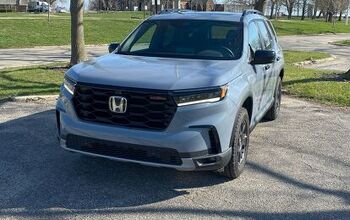U.S. Midsize Pickup Truck Market Share Jumped to a 13-Year High in 2019; Sales Rose 22 Percent
With best-ever sales from the segment-leading Toyota Tacoma, sales of midsize pickup trucks in the United States jumped 22 percent in 2019. That’s nearly nine times the rate of growth experienced by full-size pickup trucks in the U.S. last year, enough to drive market share of the smaller trucks to a 13-year high.
In fact, for the first time since the economic collapse of 2009, more than one-fifth of the pickups sold in America were not full-size trucks.
The Tacoma, which only inched forward in 2019, is not deserving of all the credit. New and reborn pickup truck nameplates contributed 130,000 sales to the midsize ledger over the last 12 months. That was more than enough to dramatically shake up the segment.
Whether due to their own old age or the reincarnation of GM’s old Ford Ranger rival, sales of the Chevrolet Colorado and GMC Canyon took an 8-percent year-over-year hit in a segment that grew its sales by 22 percent. The Colorado and Canyon, like the Ranger, were briefly discontinued trucks before returning from hiatus in time for the 2015 model year. There’s no denying the twins continue to sell at a high level. Their combined 155,129 sales earned the duo nearly one quarter of the market in 2019, second only to the Tacoma’s 39-percent market share.
Forever battling supply constraints that intermittently limit Tacoma sales, Toyota’s incremental year-over-year growth in 2019 (1.3 percent) comes after a 24-percent surge in 2018. The Tacoma hasn’t quite maxed out, but at over 20,000 sales per month, it’s the only truck to generate anything like the sales volume produced by the top full-size trucks. The Tacoma actually outsold the GMC Sierra by a 7-percent margin in 2019.
With a replacement finally in sight, U.S. sales of the Nissan Frontier fell 16 percent from the model’s 2016 high-water mark. Largely unchanged over the span of a decade and a half, the Frontier was finally knocked off the midsize truck podium in 2019 thanks to the Ranger rise. Still, for Nissan, over 70,000 Frontier sales is a gift: the tooling has been paid off many times over and the outgoing Frontier – unrefined, utilitarian, unreasonably challenging to u-turn – is basically a license to print money.
Praised by critics but generally loathed by consumers, the Honda Ridgeline ticked up slightly after slumping in 2018. Only 1 out of every 20 midsize truck buyers choose the Ridgeline; only 1 percent of the 3.1 million overall truck buyers fall for its charms. Ridgeline sales peaked in its first full year, 2006, when 50,193 were sold. 2019 was the nameplate’s sixth-best year on record.
Midsize Truck20192018YOY % ChangeToyota Tacoma248,801245,6591.3%Chevrolet Colorado122,304134,842-9.3%Ford Ranger89,571——Nissan Frontier72,36979,646-9.1%Jeep Gladiator40,047——Honda Ridgeline33,33430,5929.0%GMC Canyon32,82533,492-2.0%Midsize Trucks639,251524,23121.9%Full-Size Trucks2,481,3302,420,1622.5%TOTAL3,120,5812,944,3936.0%As sales of the Jeep Wrangler slipped by 12,000 units, the brand added 40,047 sales via the Wrangler-based Gladiator. To an extent, the Wrangler competes off in its own corner of the playground. It’s sized a bit different, priced a bit different, and is available with a range of components (three engines, for example, or soft and hard tops) that competitors don’t offer. The Gladiator joins the Ridgeline and Canyon by bringing up the rear of the segment, in the Gladiator’s case with just 6 percent of the market. Unlike Honda, of course, the Gladiator has an extremely high-volume relative in the full-size sector. There were very nearly as many Ram trucks sold in 2019 as there were midsize trucks.
As a one-two punch, however, nothing competes with the Ford F-Series and Ford Ranger. Combined, Ford’s truck lineup produced 986,097 U.S. sales in 2019, the most since 1,022,421 were sold in 2005. Today, with 89,571 annual sales, the Ranger isn’t just a bigger and more capable and less popular truck than it was when Ford averaged over 300,000 Ranger sales per year in the 1990s, it’s also positioned in a very different corner of the market. In 2008, Ranger pricing started just a tick over $15,000, nearly $5,000 less than a basic Toyota Camry. Today, pricing for the base Camry and base Ranger fall neatly in line with one another.
All told, with the midsize segment shaping up in a distinctly modern format, truck buyers in the U.S. turned to midsize trucks for 20.5 percent of their truck acquisitions. That’s not quite back to the pre-recession 21.2-percent perch observed in 2006, but it’s nearly double the share midsize trucks produced only five years ago.
[Images: Ford, Toyota, Fiat Chrysler]
Timothy Cain is a contributing analyst at The Truth About Cars and Driving.ca and the founder and former editor of GoodCarBadCar.net. Follow on Twitter @timcaincars and Instagram.
More by Timothy Cain
Latest Car Reviews
Read moreLatest Product Reviews
Read moreRecent Comments
- ToolGuy TG likes price reductions.
- ToolGuy I could go for a Mustang with a Subaru powertrain. (Maybe some additional ground clearance.)
- ToolGuy Does Tim Healey care about TTAC? 😉
- ToolGuy I am slashing my food budget by 1%.
- ToolGuy TG grows skeptical about his government protecting him from bad decisions.





































Comments
Join the conversation
Just yesterday I saw a steelie wheeled new Ranger. I want to like these... but man, turbo-4 with an automatic just doesn't do it for me. Yeah I know it's way faster than my Nissan hardbody of yore, but I really don't want or need that much performance for a small truck. It's for hauling junk and project stuff, not for drag racing.
Remember when Ford said the Ranger was not necessary because it's so big and people will just buy an F-150?